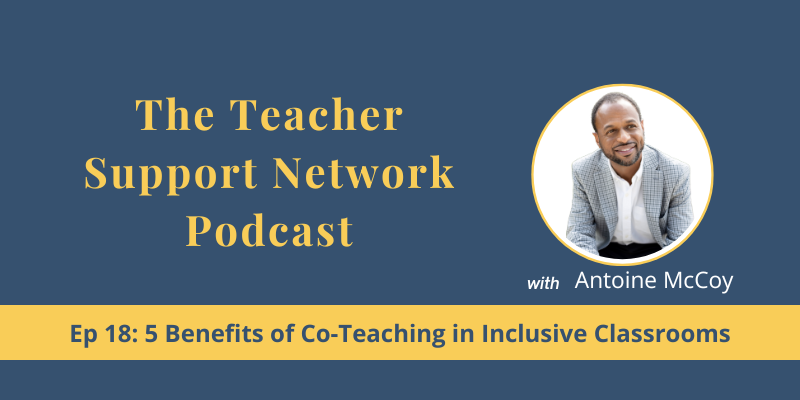
In this episode ~
In this episode of the Teacher Support Network podcast, we explore the transformative value of co-teaching in building inclusive classrooms and supporting students with disabilities.
Five key benefits of co-teaching partnerships are outlined and discussed. In addition, Antoine shares personal insights from his 18 years of experience teaching directly in inclusive classrooms using the co-teaching model.
Listen in~
00:00 Introduction to Co-Teaching
00:31 What is Co-Teaching?
01:17 Benefit 1: Differentiated Instruction
01:50 Benefit 2: Increased Student Support
02:25 Benefit 3: Improved Academic Outcomes
03:21 Benefit 4: Stronger Social Inclusion
04:02 Benefit 5: Professional Growth for Teachers
05:22 Final Thoughts and Resources
Useful Resources:
Download Gen Ed & SpEd Teachers Collaborative Conversations Guide here.
Join my Newsletter for a weekly dose of practical strategies, tips, resources and inspiration to support you on your teaching journey here.
Transcript
Hey there, teachers. I'm Antoine McCoy and welcome to the Teacher Support Network podcast. Today we're gonna be talking about a topic that's really transformative and helping to build inclusive classrooms and supporting our students with disabilities. Specifically, the topic we're gonna talk about is the value of co-teaching.
In this episode, I'm gonna briefly talk about five benefits to co-teaching that positively impact students and teachers, alike. So, first let's talk a little bit about what exactly is co-teaching. Well at its core, co-teaching is when a general education or a special education teacher (and it also can include support staff as well, like an instructional assistant).
You both share instructional responsibility for students in a single inclusive classroom, specifically those with disabilities. And it's not just two teachers in a room. When it's done right and with intention, it's a partnership that can drastically improve student outcomes.
So here are five big benefits of using co-teaching as a strategy to support students with IEPs and other struggling learners in a mainstream classroom.
Benefit number one- differentiated instruction. With two teachers, lessons can be adapted in real time. One might lead instruction while the other modifies a task, or offers accommodations, or provides enrichment to other students. With co-teaching, it can be built in differentiation without having to pull kids out of the classroom where they may miss crucial instruction with their grade level peers.So one of the first benefits of co-teaching as a strategy is differentiation in instruction.
Let's talk about benefit number two-increase student support. So imagine a student getting stuck on a math problem or any other type of problem, and instead of having to wait for the teacher to circle back to them because they're the only qualified adult in a room, now there's another qualified adult ready to help one-on-one or with small group support and it becomes a part of the norm in the classroom. As a result, it builds a greater level of support for all students, not just those with disabilities.
Benefit number three of using co-teaching as a strategy is improved academic outcomes.
Research and studies have shown that students with disabilities often do better academically in co-taught settings. The reason is they're exposed to the grade level content. They're supported by teachers in real time. Maybe they also get support in a pullout environment, which is meaningful. But being able to be supported in real time also is super important in helping students get the information, learn it, and also just to intervene right there in the moment. Another benefit is that they can be challenged appropriately at their level in the classroom. So benefit number three is improved academic outcomes because you have two teachers in the room that's there to help support a student right where they're at in the moment.
Benefit number four is stronger social inclusion. So co-teaching promotes true inclusion, not just physically sharing a space, but students feel like they belong. Students with disabilities are full members of the classroom environment, making friends, participating in discussions, and it helps build their confidence. Not only that, it benefits both them and they're non-disabled peers as well. So that's the social piece. It’s not just the academic piece we talked about in benefit three.
Finally, benefit number five-professional growth for teachers.
Now, this one I think is really kind of underrated, but it's a great byproduct of what co-teaching can do not just for students, but also for us as teachers. Co-teaching builds bridges between educators. You learn from each other. We learn from each other. We get to see each other's strengths. You also get to reflect on your practice together and can often discover new ways to engage students that you might not have found on your own.
When I think about myself in my 18 years specifically teaching in the classroom as a SpEd teacher in K-12 settings, I've been actively engaged in the co-teaching model in every school system that I've taught in with gen ed teachers, and I’ve taught in New York City, northern Alabama, and in the state of Oregon.
I grew professionally as a teacher so much in those settings just learning from my colleagues and reflecting on my practice with them to help support all students, but especially those students who had academic, social and behavioral challenges. It is a nice added benefit to embracing the co-teaching model that we often have, sometimes I think we forget, but we become stronger and better educators I think in the process.
So if you're an educator or an administrator thinking about co-teaching or you're already doing it, know this. When it's done with the right mindset, intention, and proper planning, co-teaching can really change the lives of our students.
And yes, there will always be students who will need additional supports that may be outside of the general education environment, but as much as possible, let's work together with our students with disabilities in the least restrictive environment. Not, not only do they benefit from it, but also the whole community benefits from it as well, especially when it's done really well.
So thanks for tuning into this episode of the Teacher Support Network podcast. If you found this helpful, make sure to subscribe on your favorite podcast platform and share this episode with a colleague.
And hey, let us know how co-teaching is working in your world in the comment section on this episode's show notes page. While you're there on the show notes page, grab your Gen Ed and SPED Teachers Collaborative Conversations Guide in the resource section. In that same section, be on the lookout for free training on how to have smarter collaboration and co-teaching partnerships between Gen Ed, SpEd teachers, and other crucial stakeholders who support students with disabilities.
Well, that's it for now. Thanks for tuning into this episode. I'll see you on the next episode of the Teacher Support Network podcast. Bye for now.
Rate, Review, & Subscribe on Apple Podcasts
Enjoy this episode?
Please consider rating and reviewing the podcast! Your support helps me support more teachers - just like you - create inclusive classrooms, foster effective teacher collaboration, and find balance with the demands of teaching in and outside of the classroom
It's easy! Click here, scroll to the bottom, tap to rate with five stars, and select "Write a Review." I'd love to know what was the most helpful or encouraging about the episode!
While you're there, you can subscribe to the podcast if you haven't already. If you're not subscribed, you may very well miss out on future episodes. 🙂 Subscribe now!


